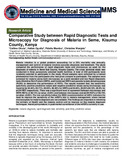Comparative Study between Rapid Diagnostic Tests and Microscopy for Diagnosis of Malaria in Seme, Kisumu County, Kenya
Date
2020-11-03Author
Okuta, Celline
Ogolla, Hellen
Mambo, Fidelis
Wanjala, Christine
Metadata
Show full item recordAbstract
Malaria infection is a global problem accounting for a 25% mortality rate annually,
management and control of malaria involves accurate diagnosis and treatment. The study
compared the performance of rapid diagnostic tests and microscopy as used for the
diagnosis of malaria in Seme Sub County, Kisumu County. The cross sectional study was
conducted in three purposively selected health facilities. A total of 230 participants were
randomly selected to participate in the study. Blood samples were collected by a trained
phlebotomist from the participants who had given consent to participate. The samples were
screened for malaria using both microscopy as a gold standard and two Rapid diagnostic
tests (Histidine Rich Protein (HRP2), and Combined HRP2 and parasite lactate dehydrogenase
(PLDH) to determine the performance of RDTs. The results revealed that, the sensitivity,
specificity, positive predictive values and negative predictive values using microscopy was
found to be 94.44%, 85.71%, 80.95%, 96.00% for HRP2 and 94.44%, 85.00%,80.19% ,95.9% for
pLDH RDT respectively. There was a significant level of agreement between microscopy and
HRP2 RDTs of 89.13% (p-value <0.001) and between microscopy and pLDH RDTs of 88.70%
(p-value <0.001). The low sensitivity below the WHO recommendation of ≥95% indicates the
need to improve the sensitivity of the mRDTs kits in malaria management, where trained
microscopists for malaria diagnosis are not available .The findings are important in informing
the ministry of Health and the malaria control unit to improve on the malaria diagnosis
techniques. Assist policymakers in post market surveillance of the mRDTs currently in use.
URI
https://mail.premierpublishers.org/mms/201020208765http://ir-library.mmust.ac.ke:8080/xmlui/handle/123456789/2024
Collections
- Journal Articles [411]

